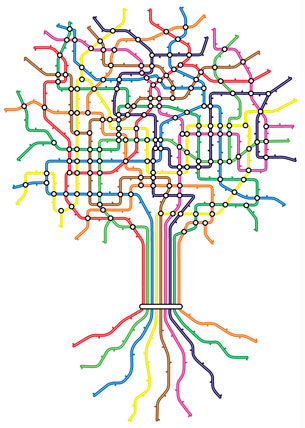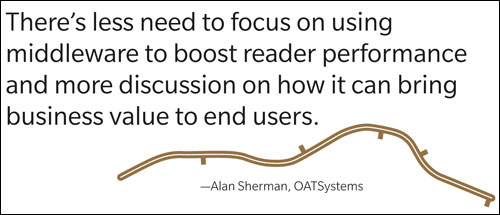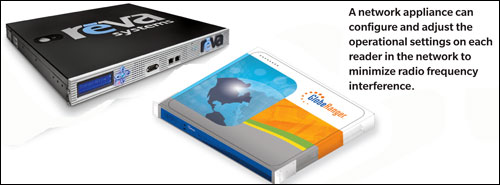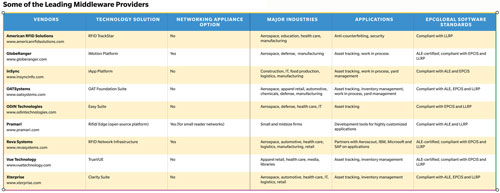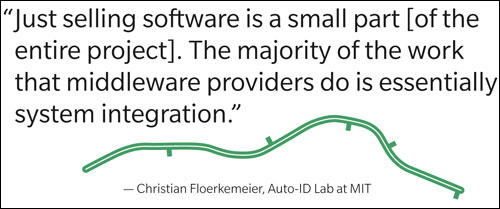Radio frequency identification systems often require middleware—software that resides between RFID interrogators and enterprise software. Middleware serves a number of key functions: It configures and manages your hardware, such as interrogators, printer-encoders and motion sensors, so they operate optimally. And it processes tag data, filtering out duplicate tag reads and aggregating the data that’s passed along to back-end applications.
Early RFID middleware resided on a computer server and included basic reporting tools. But technology innovations have brought about changes in both areas.
Today, middleware can run on a dedicated computer at each facility where RFID interrogators are deployed, on each interrogator or on a networking appliance where the technology is used. These solutions are often called “edgeware,” because they’re deployed close to the edge of the network—at, for instance, a manufacturing facility or distribution center. Middleware can also be deployed at a data center with a wide area network (WAN) to communicate with the readers. There are pros and cons to each deployment option, says Ken Traub, founder of Ken Traub Consulting, which advises end users on RFID software architecture and standards strategy.
Also, improvements in RFID technology mean there’s less need to focus on using middleware to boost reader performance and more discussion on how it can bring business value to end users, says Alan Sherman, director of marketing for middleware vendor OATSystems (a division of Checkpoint Systems). Now, many middleware vendors offer applications designed to help end users in specific industries or with particular use cases mine value from the data they collect.
In fact, middleware has evolved so much that many RFID vendors don’t even refer specifically to that term on their Web sites. Instead, some point to their platforms, while others discuss how to manage an RFID infrastructure or data flow. Almost all the vendors’ home pages highlight industry applications and solutions.
Considering that software is essential to an RFID system—some call it the central nervous system of an RFID platform—it’s no surprise the market has mushroomed. In addition to middleware vendors, many RFID systems integrators, such as ODIN and Xterprise, have developed their own software solutions.
So how do you choose the middleware solution that’s right for your company? Consider the key issues we discuss below, then check the table on page 32 to see which RFID providers offer the features that will enable you to get the best value from your RFID system.
Where to Deploy Middleware
Your RFID plans and existing IT infrastructure will help determine your options for deploying middleware. If you’re planning a small RFID deployment with just a few interrogators at one or several locations, it makes sense to run middleware directly on the reader.
For larger RFID deployments that will require more than a few interrogators in a facility, it’s generally more cost-effective to run middleware on a dedicated computer or networking appliance. Either can filter and aggregate tag data, but a network appliance can also configure and adjust the operational settings on each reader in the network to minimize radio frequency interference. If you have a large number of readers operating in a dynamic facility in which sources of RF interference fluctuate over time, a networking appliance could be a good solution to both reader-management and data-collection needs.
“If you run software on 100 readers, you have 100 software deployments, each of which has to be configured,” Traub says. “So if you have a lot of readers, it might be best to use dumb readers” and operate the middleware centrally, onsite (on a computer or appliance) or from a data center.
Patrick Sweeney II, founder of RFID systems integrator ODIN, disagrees. He says the company’s Easy Edge solution, which is installed on individual readers, uses Java-based software agents to form a peer-to-peer network and feed data back to a central server. This makes managing a network of readers easier and less costly than running middleware on an appliance or a dedicated computer, he adds.
If you have RFID deployments at multiple locations and want real-time access to your interrogators, sensors and other devices—as well as to the data they collect—consider deploying middleware at a data center with a WAN that’s in constant communication with the readers. This solution is effective if your WAN communications are fast, though you could experience latency problems due to the transmission of data between the readers and the hub. That could delay basic business processes, such as having readers trigger light stacks or other workflows in your facilities.
“Customers that intend to have a very large in-store deployment—many use cases and workflows—and/or don’t have a robust and persistent WAN connectivity to headquarters will likely want an in-store server or appliance-based model,” says Gordon Adams, senior VP of sales at Vue Technology (a division of Tyco International).
How to Mine RFID Data
Many middleware vendors offer industry-specific applications that allow you to gain business insights from the RFID data you collect. In addition, major providers of enterprise software platforms, such as IBM, Microsoft and SAP, offer interfaces that bring RFID data from device management software into those platforms, where the data is then applied to enterprise software applications for inventory control, order management or other cross-departmental functions.
Whether you use industry-specific applications or enterprise software depends on the scope of your RFID deployment. If your enterprise resource planning (ERP) system accepts RFID data and you intend to use the information for a range of applications to benefit multiple departments, it makes sense to use those enterprise applications. But if, like most companies, you plan to use RFID to automate or add visibility to specific business processes or workflows, such as shipping and receiving or asset management, within certain departments, then industry-specific applications will help you put the RFID data into context and derive business value from it.
Applications designed for asset tracking, inventory management and work in process are among the most popular offered by RFID middleware vendors.
Asset Tracking
Asset-tracking systems rely on a large number of fixed and mobile RFID interrogators, as well as other devices and technologies, such as bar codes, sensors and the Global Positioning System (GPS). Middleware providers, such as InSync Software, and systems integrators, such as ODIN and Xterprise, offer asset-tracking solutions. In addition to performing the data capture and filtering required to read and identify tagged assets, the software can, for example, trigger alerts when an asset is removed from a particular part of a facility, generate reports for managing maintenance and rental records, secure assets checked into or out of inventory, and help ensure compliance with the Sarbanes-Oxley Act.
Inventory Management
Middleware providers that focus on the retail industry, such as OATSystems and Vue Technology, offer supply-chain and in-store applications for companies that are RFID-tagging goods at the item level. Middleware can associate items to cases and cases to pallets, as well as collect RFID data from myriad devices, such as dock doors and portals, handheld readers, smart shelves, dressing rooms and point-of-sale stations. The data can be sent to the retailer’s inventory-management software or generate stand-alone inventory reports. The reports provide inventory visibility, enabling companies to improve receiving, restocking and replenishment, locate misplaced items and reduce out-of-stocks.
Click here to view a larger version of the above chart.
Work in Process
Manufacturers can deploy an RFID system to track work in process (WIP) to keep better tabs on inbound and outbound materials and monitor production steps, reducing labor costs and increasing productivity. GlobeRanger and other middleware providers offer software that not only manages the RFID devices but also runs WIP applications. It can, for instance, generate text messages or e-mail alerts and send them to floor managers whenever a potential production problem occurs, or an anticipated shipment of raw materials does not arrive or contains the wrong materials. These middleware vendors can also integrate their WIP applications with an order-management messaging system that automatically alerts customers when changes in your production schedule will lead to late or back-ordered shipments.
Choosing a Vendor
Ask if the middleware vendor or systems integrator you’re considering has experience in your industry and with the applications you plan to deploy. Also ask about services and support. “Just selling software is a small part [of the entire project],” says Christian Floerkemeier, associate director of the Auto-ID Lab at the Massachusetts Institute of Technology. “The majority of the work that middleware providers do is essentially system integration.”
Here are some other issues to consider.
Standards
To ensure that you can easily configure and build on your RFID hardware and software infrastructure, as well as share information with suppliers and clients, ask if the middleware is standards-based.
EPCglobal has developed several software standards designed to make RFID devices plug-and-play. The low-level reader protocol (LLRP) standard, for example, is a common language for adding interrogators from different manufacturers to a single RFID network. The application-level events (ALE) standard ensures tag data collected at your site is handled using common filters, which facilitates sharing information with your software applications and trading partners. And the Electronic Product Code Information Services (EPCIS) standard enables companies to share RFID tag data through a common repository.
If you plan on pulling data from your RFID system into your ERP, ask potential providers if they have experience integrating data into enterprise platforms, such as Microsoft’s BizTalk or IBM’s WebSphere. Middleware providers use standard interfaces to perform this integration; some ERP platforms certify middleware providers, but middleware companies do not need certification to integrate into ERP platforms.
Cost
As with most software-based products, middleware costs will depend on the size and scope of your project: the number of interrogators and other devices you’ll need to manage, and how you plan to mine the RFID data to get business value. Look for a middleware vendor that lets you start small and grow your RFID infrastructure over time—at one site, or at locations across the country or around the world. Keep in mind that vendors generally provide discounts for customers that deploy at multiple locations. Also, the section on “Where to Deploy Middleware” provides tips on choosing a cost-effective solution.
If you’re planning on porting the RFID data into your ERP, you’ll need to purchase only reader-management and data-capture software. Industry-specific applications are sold separately as modules, so you can buy those that will help you solve your most pressing problems, then add on to achieve more efficiencies.
While middleware is essential to any RFID deployment, you’ll still want to consider your return on investment. A retailer might pay in the ballpark of $35,000 for a full implementation of Vue Technology’s middleware platform—which includes everything from edgeware to industry-specific applications—for its initial store rollout, says Adams. But, he adds, that same retailer might see an ROI in less than 12 months, thanks to improved product visibility and inventory accuracy.

